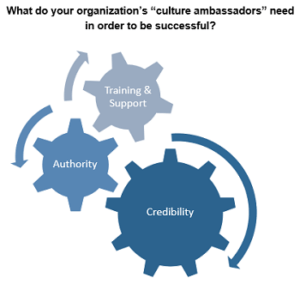Building a Dynamic Organizational Culture: It Takes More than Leaders
These days, management journals, nonprofit sector blogs, LinkedIn, and other sources of information for organizational leaders offer a steady stream of tips, tricks, and advice on how to build a dynamic and engaging organizational culture. This is particularly so for organizations entering into strategic partnerships or merger. “The leaders need to set the tone” is among the most common takeaways.
To be sure, this bit of conventional wisdom is based in direct experience. Without a clear sense of values, tone, and priorities being modeled by those in titled positions of leadership, an organization (whether on its own or in a newly-created partnership) will stumble in its efforts to develop a culture that aligns in support of its mission and that fosters an environment in which its staff can thrive.
And yet, while leadership IS a critical driver of organizational culture, simply having a leadership team announce its beliefs from on high, without active engagement and partnership with staff throughout the organization, is far from sufficient to build and sustain the kind of culture most of us seek in our organizations. Equally as important, I submit, are those members of the staff seen as influencers: mid-level managers; project team leaders; the informal tone setters within your organization (we sometimes refer to them as “ambassadors”). These individuals, representing all levels, departments, sections, and areas of work, are critical to ensuring that the broader set of staff perspectives are heard by leadership and reflected in the values, tone, and priorities that leaders espouse. These ambassadors also represent the first line of response to the thinking of leadership. If leaders’ thinking does not align with that of the ambassadors, leadership will be hard-pressed to socialize these cultural elements throughout the full organization.
So, what do these ambassadors need in order to be successful?
First and foremost, they must have credibility within their organization as leaders and influencers. Staff at all levels must believe that these individuals understand the organization and the various experiences and perspectives of staff throughout the organization. They must also have at least implicit authority from titled leadership to act in this role. Without this combination of credibility and authority, ambassadors will be less likely to effectively diffuse and socialize new elements of the organization’s culture.
They also need training and support. Too often in our organizations, staff are promoted into mid-level leadership roles and  not given the tools and guidance needed to be effective. Moreover, given that they occupy a middle space—not having the full authority of senior leaders while also not always seen as “staff”—ambassadors benefit from the support of their peers. And so, providing initial training on their role as supervisors and managers (for those given these structural roles), as well as training on understanding culture change processes and how they can support and advance these changes, will increase the likelihood that they will succeed in this role.
not given the tools and guidance needed to be effective. Moreover, given that they occupy a middle space—not having the full authority of senior leaders while also not always seen as “staff”—ambassadors benefit from the support of their peers. And so, providing initial training on their role as supervisors and managers (for those given these structural roles), as well as training on understanding culture change processes and how they can support and advance these changes, will increase the likelihood that they will succeed in this role.
Helping ambassadors understand, for example, how individual and collective identities affect how staff experience a workplace, will enhance their ability to understand staff responses to the new culture and the process of change. Similarly, developing their ability to build trust, provide feedback to staff from diverse backgrounds and at different levels of the organization, and engage in productive conflict and decision-making, will further enhance their ability to hear staff questions and concerns about the new culture, and to channel those concerns into productive reflection, input, and behavior. And, combining these learning opportunities with the space to meet regularly as a group to share experiences, challenges, and strategies will enhance their skills, strengthen relationships, and further contribute to the successful development of a dynamic and engaged culture.
When organizations broaden their conception of “leadership” to extend beyond simply the people at the top of the org chart, they create an environment that values and includes the thinking of staff. Not only will this help advance the development of an engaging organizational culture, but it will also deepen the engagement of staff at all levels by creating opportunities for leaders to emerge from within. Deeper engagement will, in turn, result in a higher level of commitment to the organization’s success and impact. And, after all, isn’t that the point?!


Comment section
1 thought on “Building a Dynamic Organizational Culture: It Takes More than Leaders”